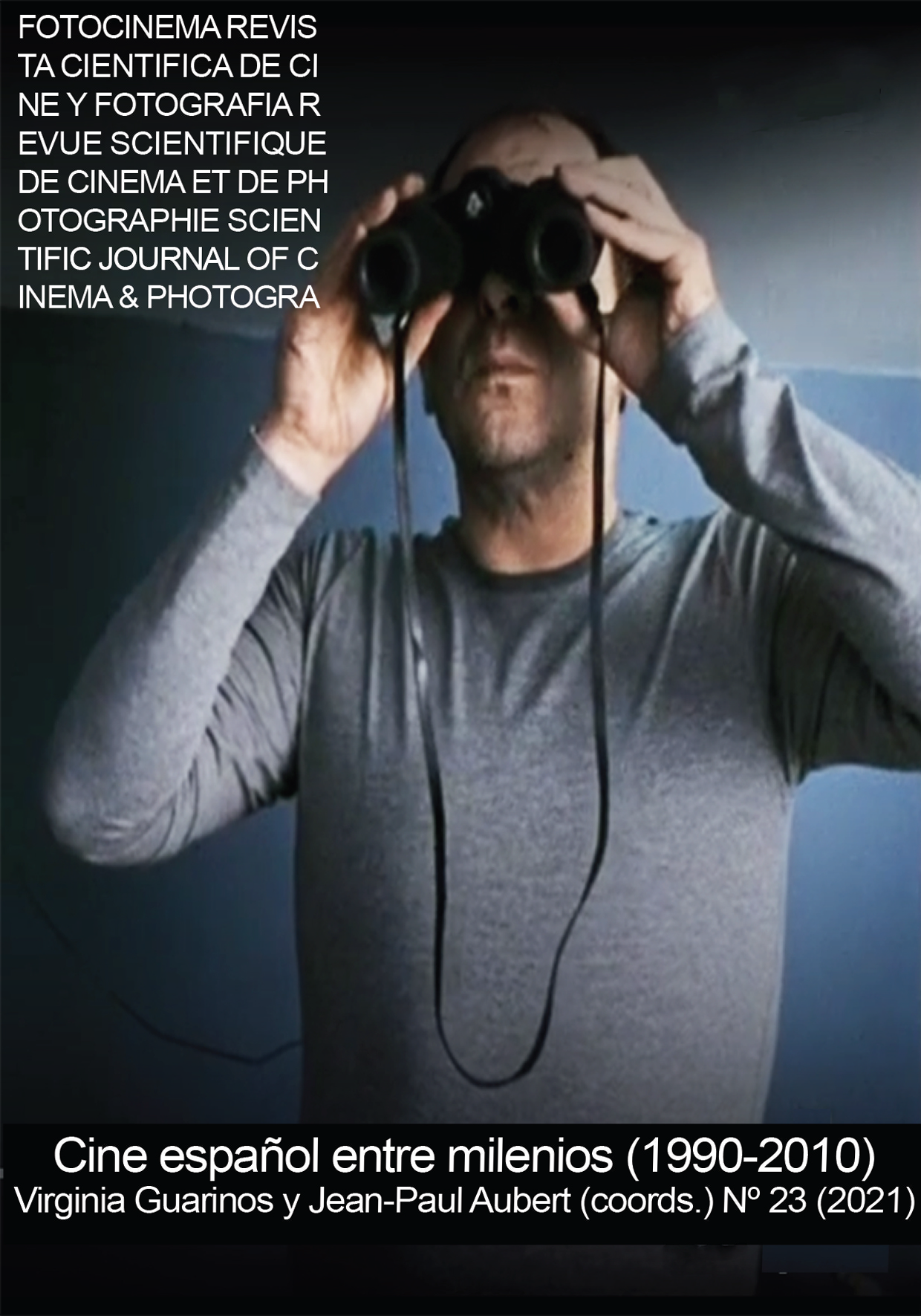Languidness of August (1984)
Cesare Pavese’s The Beach (1945) in Jorge Silva Melo
DOI:
https://doi.org/10.24310/Fotocinema.2021.v23i.12366Keywords:
Portuguese cinema, Italian literature, Cesare Pavese, Jorge Silva Melo, materialitiesAbstract
In 1987, the Portuguese filmmaker Jorge Silva Melo (b. 1948) filmed an adaptation of La Spiaggia, a novel that the Italian writer, translator and screenwriter Cesare Pavese (1908-1950) published in 1942. It was one among many adaptations of the Pavesian work for cinema, but the very first in Portuguese cinema. August, the film, would debut in 1991. However, the name of Pavese would only be credited in the promotional materials after the premiere. Such absence does not prevent – it rather incites, since it arouses curiosity – a close-reading in parallel of the two works, in an attempt to see in them marks of authorial expressiveness and a very particular and symbolic reading that the Portuguese filmmaker seems to make of the book by Pavese. Both works share particular narrative elements; but mainly they have stylistic traits in common, which we believe this comparative reading underlines. In seeking their identification we sought the published testimonies of both authors, as well as a film analysis centered on the treatment of images, sound, music, materiality, construction of dialogues, appeal to voyeurism and the performance of the main actors.
Downloads
Metrics
Publication Facts
Reviewer profiles N/A
Author statements
Indexed in
-
—
- Academic society
- N/A
- Publisher
- Universidad de Málaga
References
[s.a.] [2013]. Folha de Sala relativa à exibição de Agosto no Cinema Monumental, em Lisboa, a 15 de junho.
Catalfamo, A. (2004). La Stanza degli Specchi: Cesare Pavese nella letteratura, nel cinema e nel teatro: quarta rassegna di saggi internazionali di critica pavesiana. Centro Pavesiano Museo Casa Natale.
Cavallini, E. (2013). “Da Brancaleone a Forte dei Marmi: Pavese e il ‘mare greco’”. In Catalfamo, A. (a cura di), Cesare Pavese: Il mito classico e i miti moderni (pp. 5-14). Edizioni CUECM.
Ferreira, F. (org.) (2013). O Cinema de Jorge Silva Melo e os Sortilégios do Tempo. Lisbon & Estoril Film Festival ’13.
Freud, S. (1905). “Três ensaios sobre a teoria da sexualidade”. In Um Caso de Histeria, Três Ensaios sobre a Teoria da Sexualidade e outros Trabalhos (1901-1905) (pp. 123-250). Trad. Jayme Salomão. Edição standard brasileira das obras psicológicas completas de Sigmund Freud, 7. Imago, 1969.
Kracauer, S. (1997). Theory of Film: The redemption of physical reality. Princeton University Press.
Mexia, P. (2018). Lá Fora. Tinta-da-China.
Mulvey, L. (1983). “Prazer visual e cinema narrativo” (pp. 437-454). Trad. João Luiz Vieira. In: Xavier, I. A Experiência do Cinema. Edições Graal.
Nay, L. e Zaccaria, G. (2017). “Nota introduttiva”. In Pavese, C. La Spiaggia (pp. v-xiv). Giulio Einaudi Editore.
Pavese, C. (2021a). La Bella Estate. Introd. Claudia Durastanti. Giulio Einaudi Editore.
Pavese, C. (2021b). Dialoghi con Leucò. Introd. Giulio Guidorizzi, con una conversazione tra Carlo Ginzburg e Giulia Boringhieri. Adelphi.
Pavese, C. (2021c). A Lua e as Fogueiras. Trad. José Lima. Livros do Brasil.
Pavese, C. (2020a). Il Mestiere di Vivere: Diario 1935-1950. Introd. Domenico Starnone. Giulio Einaudi Editore.
Pavese, C. (2020b). La Luna e i Falò. Introd. Wu Ming, con una nota di Laura Nay e Giuseppe Zaccaria. Giulio Einaudi Editore.
Pavese, C. (2017a). Feria d’Agosto. Introd. Elio Gioanola. Giulio Einaudi Editore.
Pavese, C. (2017b). Il Compagno. Giulio Einaudi Editore.
Pavese, C. (2011). A Praia. Trad. Ana Tomás. Ulisseia-Babel.
Pavese, C. (2009). Il Serpente e la Colomba: Scritti e soggetti cinematografici. Ed. Mariarosa Masoero, introd. Lorenzo Ventavoli. Torino: Giulio Einaudi Editore.
Pavese, C. (2008). Férias de Agosto. Trad. Ana Hatherly. Quasi.
Pavese, C. (2004). O Ofício de Viver. Trad. Alfredo Amorim. Relógio d’Água.
Pavese, C. (2002). Tutti i Racconti. Giulio Einaudi Editore.
Pavese, C. (1969). Ciau Masino. Giulio Einaudi Editore.Ramos, J. L. (1991). “Música de Verão”, EXPRESSO / REVISTA, 11 de maio de 1991. Disponível em:
Vasconcelos, J.M. de (2013). “Os Deuses de costas (Pavese, Dialoghi con Leucò e os mitos)” (pp. 43-56). In Boletim de Estudos Clássicos, 58. Associação Portuguesa de Estudos Clássicos / Imprensa da Universidade de Coimbra.
Downloads
Published
How to Cite
Issue
Section
License
All contents published in Fotocinema Revista científica de cine y fotografía are protected under the Creative Commons Attribution-NonCommercial-ShareAlike 4.0 International (CC BY-NC-SA 4.0) license. All about this license is available in the following link: <http://creativecommons.org/licenses/by-nc-sa/4.0>
Users can copy, use, redistribute, share and exhibit publicly as long as:
- The original source and authorship of the material are cited (Journal, Publisher and URL of the work).
- It is not used for comercial purposes.
- The existence of the license and its especifications are mentioned.
There are two sets of authors’ rights: moral and property rights. Moral rights are perpetual prerogatives, unrenounceable, not-transferable, unalienable, imprescriptible and inembargable. According to authors’ rights legislation, Fotocinema. Revista científica de cine y fotografía recognizes and respects authors moral rights, as well as the ownership of property rights, which will be transferred to University of Malaga in open access. The property rights are referred to the benefits that are gained by the use or the dissemination of works. Fotocinema. Revista científica de cine y fotografía is published in an open access form and it is exclusively licenced by any means for doing or authorising distribution, dissemination, reproduction, , adaptation, translation or arrangement of works.
Authors are responsable for obtaining the necessary permission to use copyrighted images.














13.png)



